![7 More Ways to Curate Content Like a Pro [New Examples]](https://www.liveseo.com/wp-content/uploads/2022/04/7-More-Ways-to-Curate-Content-Like-a-Pro-New.png)
While painters and sculptors create the art, museum curators select the pieces to include in an exhibit.
The best curators understand the museum’s mission and audience and choose stories to create an experience that will draw in and engage visitors. They decide which artists to highlight and how to present the information for their audiences to consume.
Curation is a powerful practice for content marketers, too. It can take many forms, from a simple display of resources to a well-detailed analysis piece. It can bring multiple benefits to your content marketing strategy, allowing you to:
- Create more content with less effort
- Help with SEO through internal and external linking
- Become a go-to resource for your topic/industry
A few years ago, a friend of CMI, Heidi Cohen, offered this succinct definition of content curation from a content marketing perspective:
To meet your audience’s information needs, content curation is the assembly, selection, categorization, commentary, and presentation of the most relevant quality information. You add your human editorial perspective while integrating your 360-degree brand.
Let’s explore several ways to adopt a content curation strategy to deliver practical, sometimes original, and occasionally personalized content for your audience.
But before we do, I want to take a moment to remind you that curation must be transparent: give proper credit, including links, to the original sources.
Content curation is a powerful #ContentMarketing tool, but transparency matters. Give proper credit, including links, to original sources, says @AnnGynn via @CMIContent. Click To Tweet
1. Offer a list of relevant reading, listening, or viewing
Christopher Penn of Trust Insights curates content in his weekly newsletter, Almost Timely News. On his subscriber sign-up page, he explains why (and it’s really the primary audience benefit of most curated pieces):
I know you’re busy. I know you’ve got a million things to do, a lot going on, and have a million different things vying for your attention every day. The newsletter provides a nice roundup of the week’s stuff, stuff you don’t want to let slip through the cracks.
The newsletter’s “What I’m Reading: Your Stuff” section offers an excellent example of a simple approach to curation. The section includes bullet lists of headlines and links to “the most interesting content from around the web on topics you care about, some of which you might even have written.”
The image below shows how Christopher adds value for his readers by organizing the links into categories they can quickly scan to find the most relevant or interesting ones. In this example, the categories include:
- Social media marketing
- Media and content
- SEO, Google, and paid media
Under each category heading, Christopher links to three articles, using the original articles’ titles. Under the social media marketing heading in the image, for example, he lists What is Social Media Marketing Automation: 10 Tools To Save Time.
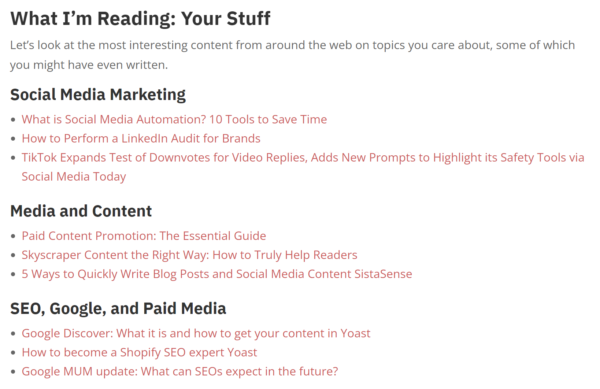
Takeaway: Aim for helpful content. What does your audience want to know? Who has created content that can answer their questions? Scan those resources and pick the most relevant ones. Your audience will appreciate not having to do the work themselves.
When curating #Content, think about what your audience wants to know, then pick the most relevant resources to answer their questions, says @AnnGynn via @CMIContent. Click To Tweet
2. Write an original article by tailoring others’ content for your audience
Influencer Marketing Hub created an original article (The Best Times To Post on Facebook) by curating several research-based original articles from Sprout Social, Buffer, and CoSchedule.
Most of the piece relies heavily on the Facebook section of the CoSchedule article The Best Times To Post on Social Media in 2019 According to 25 Studies, even including CoSchedule’s original graphic showing recommended Facebook posting times, as the image below shows.
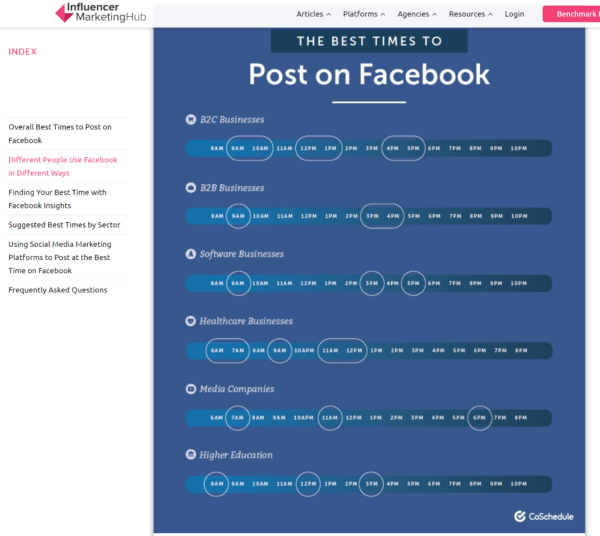
Takeaway: Original research makes great fodder for content curation. You can build on the investigative work someone else did by sharing the most relevant insights with your audience.
3. Simplify social threads
The little spool of thread emoji appears more frequently on Twitter and other social media platforms these days. TLDR Crypto often curates some of these threads into bite-size content for its newsletter audience.
Their model briefly explains the key point or conclusion from the thread and a brief background explanation, if necessary, accompanied by a link to the original thread.
In this example, TLDR Crypto explains the topic (stablecoin farming) and then shares what the Twitter thread from Aylo of alpha please covers (a spread-out risk strategy):
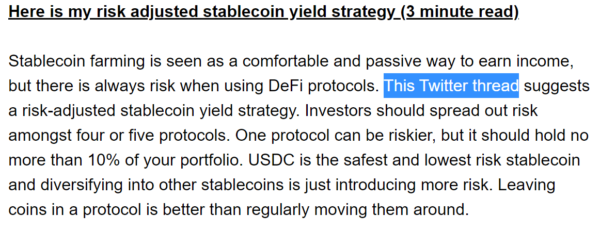
Takeaway: Social media is awash with threads. It can be challenging for most people to keep up with the volume or discern the ones most relevant to them. Your brand can do it for them. This curated content also can be helpful to those who don’t use social media regularly. You can also curate the threads into an easier-to-consume format. Twitter threads, for example, can be cumbersome to read (especially if you don’t have Twitter Blue). Digesting them in a single paragraph makes the content easier to consume.
Curate #SocialMedia threads into easy-to-consume #Content summaries for your audience, says @AnnGynn via @CMIContent. Click To Tweet
4. Bring together multiple sources
The Newsette goes all-in with content curation throughout its daily news email to help educate and empower women. It takes a theme or topic and finds multiple sources to develop it.
For example, in a less-than-300-word piece entry on fitness that ran in the newsletter, the writer takes readers on a quick, highly curated ride. First, they talk about short bursts of exercise (citing three sources). The writer makes their own point (original content) about a study on the benefits of bicycling (the research involved only eight participants). Then, the writer cites another source about how moderation leads to stamina, noting how the target discomfort level (another source) makes that hard to achieve. With input from an exercise physiologist, they conclude that people should treat exercise as fun more than medicine.

Interestingly, the curated sources were diverse – national media, local media, blogger, medical journal, etc. They included Slate, Pittsburgh Post-Gazette, She’s a Beast: A Swole Woman’s Newsletter, Fortune, National Library of Medicine archives, and The New York Times. While most of the referenced articles were published this year, the medical study was published in 2017, and The New York Times piece was undated.
Takeaway: Don’t just curate content from traditional and expected industry media. Solo bloggers, local media, journals, and more can provide relevant content inside and outside your niche. Often, they help you tell stories in unique ways that may surprise your audience or at least get your audience’s attention.
5. Appeal to many
Avalara, a tax compliance solution provider, took the time to curate a list of how each U.S. state handles sales tax on shipping. In a paragraph or two, the article explains each state’s relevant laws while linking to the full-text version and other applicable content. Readers can go directly to those states where they operate or ship to.
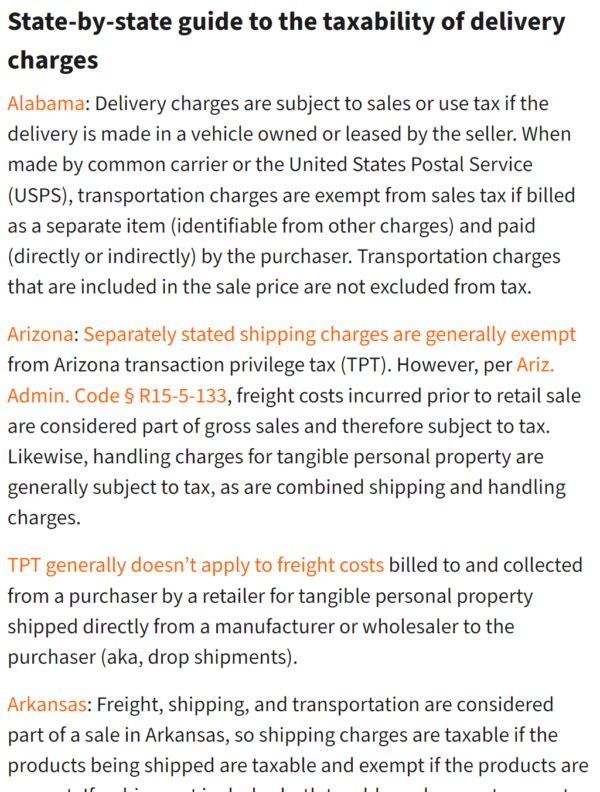
Takeaway: Curating content like this allows your audience to easily find the information relevant to them. Whether it’s geographic or subtopics in your niche, you can pull from multiple resources to tackle a big topic in a way that has something applicable for most in the audience.
6. Go deep on a topic
In The Profile, Polina Pompliano maximizes all things curation. Accompanying her 750-word feature story (The Profile Dossier) about UFC champion Francis Ngannou, she curates additional content about the UFC champ that her audience might be interested in reading, watching, or listening to. Polina creates a phrase for each item to highlight the content’s point, followed by a couple of explanatory sentences, so readers (or viewers or listeners) know what they’ll get if they click through.
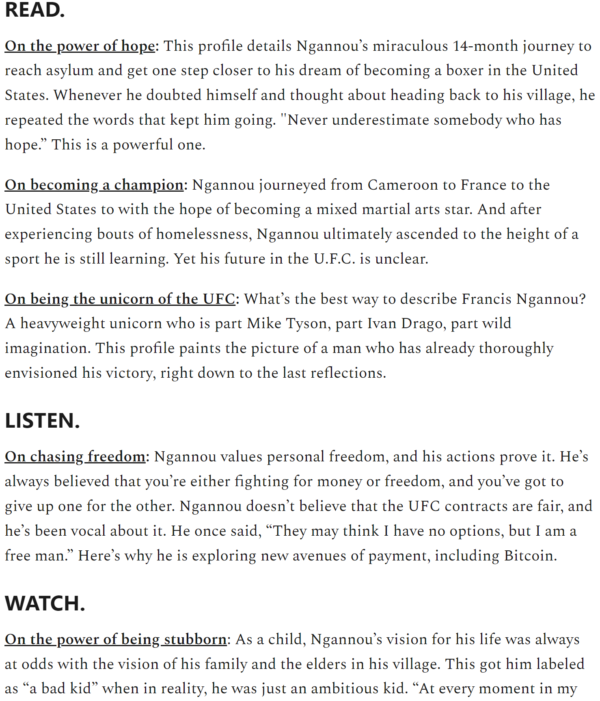
Takeaway: Show your work and make it a value-add for your audience. When you do the research for an article, podcast, or video, document all your sources (titles and links, at a minimum). After you finish the planned content, revisit your notes to create additional content. Select the most valuable resources for audience members who want to learn more and publish (or link) them with the original content.
7. Make something new from something you already created
Jodi Harris is CMI’s master of content curation. Jodi regularly creates fresh articles by combining insights and examples from her (and other CMI writers’) earlier works. For example, her recent article 9 Visual Tips and Examples From Creative Brands and Experts includes tips from published pieces by Jodi and other CMI contributors. The image below shows one such tip, Consider the story – not just the visuals, which includes a point made by Robert Rose in a different article and related video.
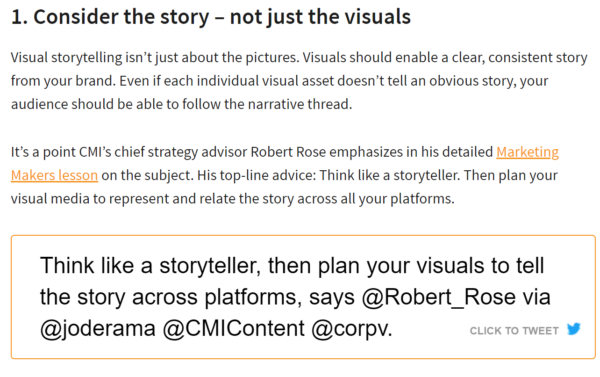
Takeaway: You likely have created a lot of content in various forms on similar broad topics. Think about how to pull together the most salient points from several to craft an original piece. You also can mix up formats. For example, you could curate information from several articles into a single podcast episode.
Be a regular content curator
Curating content is a lot like doing your audience’s homework. You’re doing them a service by doing the research, pulling together shared ideas, and finding little-noticed content.
But content curation isn’t only a benefit to your audience. It’s also a great help to your content marketing team and strategy. Curation helps you quickly develop more (and more thoroughly sourced) content.
Why not start planning your next content exhibit now?
Cover image by Joseph Kalinowski/Content Marketing Institute




